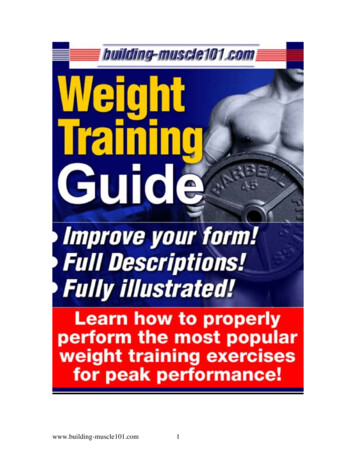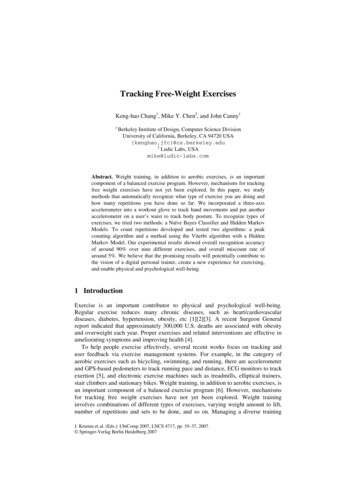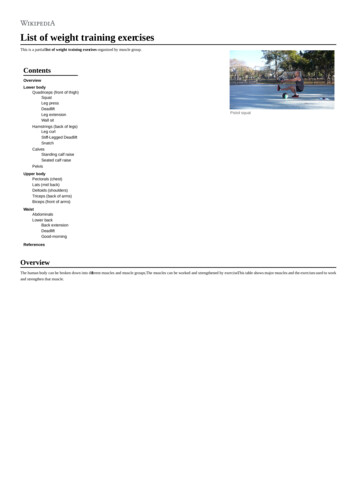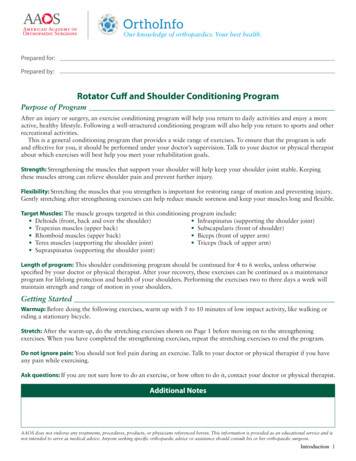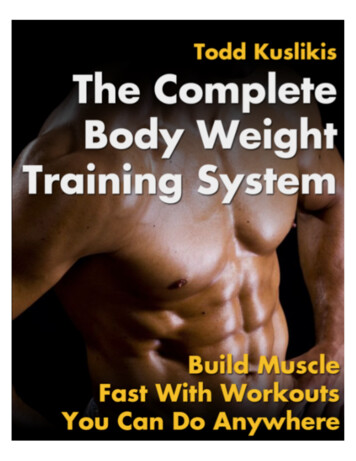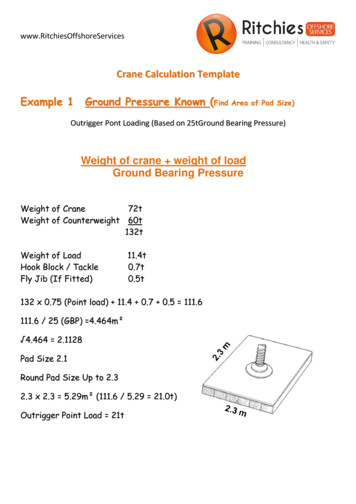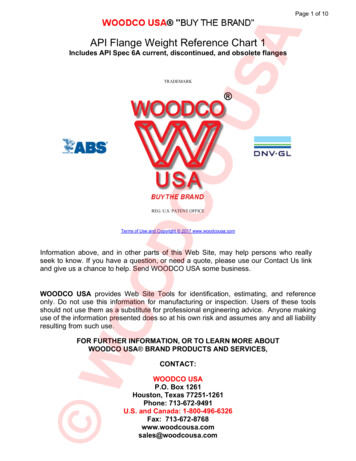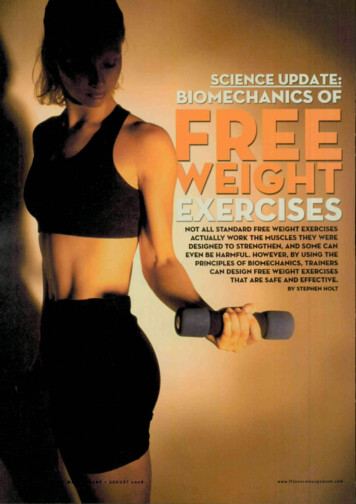
Transcription
SCIENCE UPDATE:HJIOJAANICS OFNOT ALL STANDARD FREE WEIGHT EXERCISESACTUALLY WORK THE MUSCLES THEY WEREDESIGNED TO STRENGTHEN, AND SOME CANEYEN BE HARMFUL. HOWEYER, BY USING THEPRINCIPLES OF BIOMECHANICS, TRAINERSCAN DESIGN FREE WEIGHT EXERCISESTHAT ARE SAFE AND EFFECTIYE.BY STEPHEN HOLTtllT AUGUSTwww,rifntSimanagemrnt.com
years ago writingabout biomechanics and what's good or notso good iibout certain exercises, when 1 wrotea Letter lo the Bditor (not this IMitor, ofcourse) about an exercise that a particularmagazine called the Cobra. To perform theCobra, exercisers would lie down on theirside near the low pulley of the cable crossmachine. (This was way back when the onlycable machines in a standardigym were tbe lat pulldown and,maybe, a cable cross.} Tben,exercisers performed what wasbasically a single-arm lat pulldown-type of motion.with the fandest cam-based madiinesl —since the strength curve changes not only fromperson to person, but al.so from rep to rep ina given person — a weL-designed e.\ercisesiiould at least reflect the typical strength cur\'efor tbe intended movement. An exercise isinherently less otTective tor optim.dly stressingtargeted mu.scles tbroughoul the range ofmotion if the strength ciu-\'es and resistance curves areiBIOHECHANICALLY SPEAKING,CURLS ARE A NEAR-PERFECT FREEWEIGHT EXERCISE.How this differed from simply »sitting updglit on the iai pulldownmachine and perfonning a one-arm pulldownusing a single handle, 1 don't know — and themagazine never said. Hut that's not the mainissue. Thf problem is, the magazine claimedthat exercisers could perform the same exerdse in the same body pcsition usir a dumbbell. However, with tbe cable, exercisers pulledsomewhat horizontally against a horizontalresistance. But. if they used the dumbbelloption, they'd be pulling horiziintally against adownward resistance. Not only are these notat all tbe same exercise, but tbe dumbbell version becomes a nonsensical "exercise." withabsolutely no resistance to the alleged targetmuscle.Even after all these yeare, poorly desired freeweight exercises tike this still exist. The gixxlnews is that llirtber examination of the biomechanics of many exercises bas led to some "new"techniques tliat can improve results. Not alldumbbell exerdscs are etjual. Some are inherently better than otiiers. That's not just my opinion; you can prove it with biomechanics. Someof your fevorites may be ineffective and evenpotentially dangerous. /\nd. some standards canbe made even more eftective with tbe properapplication of basic biomedianics.lent armIn pbysics, the moment arm is defined asthe perpendicular distance between tbe lineof force and tlie axis of rotation. To apply thisto an exercise, you finit draw (mentally, at least)what's called a "free body diagram." Don'tworry, with free weights, it's easy. With awww M l n e s s m a n a g e m e n tdumbbell, tlie line of force is always straightdown and directed straight through the hands.Technically speaking, you can pick any jointyou want as the axis of rotation, but typicallyyou're interested in looking at the tnain jointtargeted in the exercise.Let's use lateral raises as an example (seeFigure 1 ), The axis of rotation here is theshoulder; more specifically, the eno-humeralPulloveniI'm old enough to rememberwhen virtually every man in theweight nx)m performed pullover:» —because it "expiuuled your ribcage," as reported in virtiLilly everybodybuilding magazine of the day. Let's look at(GH) joint (Of course, there are other jointthe moment arms (see Figure 2) for tliis exermotions taking place.) Draw a straight linecise. In tlie bottom position, the moment armdown from the GH joint. Now, look at anypoint in the range ot' motion, anil draw a line— and, tberetore, tbe resistance — of tbe barstrai it down from the dumbbell or hand lliebell is maximized. Unfortunately, tlic biomedistance indicated by tbe red block in thechanics of the iMxly are working against thefigure is the moment arm. The smaller theexerciser. The lats and pecs are in a weaker posimoment arm, die less the resistance to movetion there.ment about the a.xis in question. The longerIn the top (xisition, excrdsers get just thethe moment arm, the greater the resistance.opposite effect. Since the moment arm is zeroKach joint movement has an associatedstrengtii curve that plots the joint angle andthe corresponding maximum weight that canbe handled in tlial [.xjsition. Biomechanic illyspeaking, curls are a near-perfect free weightexerdse. The strengtii airve and resistance profiles match up well. Lifters get stronger up toabout 90 degrees, then get weaker as they continue upward. In technical terms, tlie momentarm is maximal right around tlie point wherethe biceps are strongest. Tbe moment arm(and resistance) are low where strength isinherently low.llie only "issue" is that there is absolutelyno resistance to the biceps at the very bottom(wbich is okay if the exerciser has actuallyearned that tiny rest). There's also a smallamount of available range of motion in ellxiwflexion at the top past the point where theexerciser is no longer getting resistance fromthe dumbbell.Aitliough it's impossible to predsely matchstrength curves with resistance profiles (evenrelative to the shoulder, the resistance is zeraAt the same time, tbe lats and pecs are in agreat position to create torque. Worse yet. theUittom position is at or near the limit of therange of motion of shoulder flexion. Fail here— again, where resistance is maximum andstrength is minimum — and exerdsers can heat risk for an injury.Exercisers face similar problems whenperforming triceps kickbacks as they do forpullovers, but at least kickbacks are safer{see Figure 3). In the bottom position, tbetriceps are in a strong position, yet theresistance is zero because the moment armis zero. At tbe top position, the triceps areat a mechanical disadvantage; but. at thesame time, the niomcnl arm and resistanceare maximized.With kickbacks, tJie tendency is to chixwea heavy wieight, so exercisers haw; to basicallytbrow lo the top position to com[iens;ite forthe inherent weakness at that end of themotion. Or, they can pick a light weight, butFITNESSMANAGEMENT AUGUST
EducatesalculatesotivatesTake your fitness center up a notch with the#1 name in Fitness Assessment Systems.Simple to use. Powerful resuits.IVI I C R OHealth & Fitness SystemsFor a free trial CD INGSFITNESS"THE HOTTEST NAME IN FITNESS"IS SEEKING THE BEST OF THE BEST!Urban Active Fitness has immediate openings forSenior Level Management with 5 -i- years ofmulti fitness club operations.Urban Active Fitness is also hiring FitnessProfessionals at all levels.We currently operate 29 Sports Clubs and Growing.We offer Salary, Commissions, Bonus and an industryleading Benefits package, including a 401K with Match.Send Your Resume toOr Fax toWebsite: www.urbanaotive.oomGo URBAN!GetFITNESSMANAGEMENTthis Is not at all challenging through the restof the motion.OumbtwU fliesDumbbdl flies are yet another ocample ofthe resistance being maximized where exercisers have much less strength (see Figure 4).Numerous bodj-builders insist that there arelegitimate reasons to jwrform tliis exercise, hutthat's no reason for most typical members tí)perform it.Not only docs the resistance profile opposethe strength curve, the bottom position —where exercisers are weakest — can take theshoulder beyond the physiological range-ofmotion limit and cause injury. Besides, at thetop position, there is still available range ofmotion in shoulder adduction, but the resistance from the dumbbells reaches zero once thehands are directly over the shoulders.Pieachei curlsWith preacher curls, the top position hasno resistance, although there is still strengthin that j. osition. and exercisers get even morerange of motion in elbow flexion, In fact,many people make the mistake of goingbeyond the "top" position to a point wheretheir biceps can no longer do the work. Anyfurther movement beyond the "noon" position of the forearm comes from gravity, nottlie contraction of the biceps.Preadier curls are another exercise in whichthe bottom position can be [xjtentially dangerous. At the bottom, there's still some resistance from the weight, although exercisersreach the end of range of motion of theelbow. The pad itself can then be a fulcrumthat helps the weight lake them into hyper*extension of the elbow.The See-Saw PrincipteImagine two children of equal body weightsitting on a see-saw. Iheoretically. if neithermoves, they will sit there perfectly balanced.This is true regardless of the size of tlie children. In engineering, this is called a state ofequilibrium. Now, if aflylands on the headof one of the children, the see-saw will startto move. Here's how the see-saw analogyapplies to a couple of common exerci."««.Dumbbell side bends. Dumbbrll sidebends are not an inherently poor exercisewhen performed intelligently. Many people,however, make the mistake of using twodumbbells — one in each hand — for thisexercise. One dumbbell goes up as the othergoes down. What happens is, the two dumb-
bells offset each other, much like a see-saw.Tlie tiniest bit of force — as in contracting theobliques and quadratus luml'H)rum with minimal force — will move the system. "Fhe targetmuscles don't have to do much work at all.Any muscle activity exercisers feel comes frommoving tlie weight of the trunk (the head,arms and truck comprise about 2/3 of bodyweight), plus the minimal amount of forceneeded to get the dumbbells moving. Theweight ofthe dumbbells, in this case, is nearlyinconsequentialTo perform this exercise properly andintelligently, atercisers should use a singledumbbell.WrLst rotation. Golf-happy country clubtrainers see tliis mistake a lot. The action hereis pronation and supination, which takes placeat the ellx w, not the wrist. Most people grabtlie dumbbell in the middle and simply followinstructions like these copied from a popularwebsite: "With your p;ilm down, rotate yourforearm until the dumbbell is parallel to theceiling" or "this time, keep the palm tace upwhile holding onto the dumbbeU. Rotate thedumbbell until it is parallel to the ceiling."If exercisers grab the dumbbell in the natural, middle position, the two heads of thedumbbell offset each other. In order to avoidtlie see-saw effect, they should grab tlie dumbbell near the end of tlie grip; otherwise, they'rebasically wasting their time.Smarter dumbbeU exerciseLet's take another look at the shoulderabduction/lateral raise example. People arestrongest in shoulder abduction around 70degrees. If you take a look at the diagram{Figure I), you see that the ptiint of greatestresistance for this exercise is at 90 degrees. So,although the strength curve and resistance profile have the same shape, they're out of phase,with strength reaching its peak around 70degrees, and resistance reaching its peak at 90.There are two ways to address this discrepancy, with one being clearly superior tothe other.Standing leaning lateral rmses. This type oflateral raise is j quasi-cLissic tliat you can probably find in many advanced bodybuildingmagazines. It's a nice try, but the biomechanics are slightly off. For educational purposesonly, here's how to perform it: With a dumbbell in the right hand, grab a stable anchorpoint with the left hand and lean the entirebody toward the right. From there, simply perform the usual lateral raise.The usual selling point is that this changesthe resistance profile, and some argue thatany change is the resistance profile providesa useful new stimulus. When you look at thebiomechanics, however, you'll see that thestrength curve and resistance profiles areeven more out of sj-nc. The point of greatest resistance now occurs much above the90 degree abduction point, although, again,a person's strongest range of abduction isaround 70 degrees.Let's see if we can align those two curves alittle better.Telle lateral raise. I named this option forJerry Telle, author of Beyorui 2001. Again, we'llwork on the right arm, but this time, exercisers sit on a bench and lean the trunk to theleft, supported by the left iirm {see Figure 5).With about a 20 degree lean of the trunk, theexerciser better coordinates the resistance profile with the s t r e n g curve. Also, exercisers stillhave resistance, even at 0 durées of abduction,which is purported by some to stimulate thesupraspinatus more effectively. Moreover, itoptimizes the tension in the deltoids throughout the range of motion.As Telle writes, "By adjusting your bodyduring a particular exercise, yüu can maximizemuscle tension and target the muscle muchmore effectively." Seemingly simple changescan make a world of difference.Optimizing workoutsTo optimize your clients*fireeweight workouts, don't just follow what everyone else isdoing. Take a look at the biomechanics behindthe exercise first to get the most out of yourclients' workouts. F MStephen Holt is director of personal trainingat the Baltimore Countty Club Fitness Centers¡n Baltimore, Md, He can be reached atinfo@stephenholtfitness.com.GET MORE INFORMATION ONLINEIIf you found this article usefuL you can read more about this topic on Fitness Managements website in its Articles Archive at www.fitnessmanagemenLcom/articles/. Below is a list of related articles that you can find online:1. EwUrtion of Strength-Training EquipmenL By Julie M. King Ouly 2001). In the categoiy "Strength Training."2. Omsiderations tm Weightstack Exercises. By Wayne L Westcott (Deumber 2006). In the categoiy"Strength Training."3. W e Machines vs. Free Weights. By )ason R. Karp (February 2006). In the categoiy "Strength Training."THE FIRSTBAMBOOFLOORINGDESIGNEDFOR GROUPFITNESSAND YOGA.New high-performanceZentena bamboo fitnessflooring is great for yourbusiness, your membersand the environment.The pre-finished Zenterrasystem uses exclusive Exerflextechnology to provide maximumshock absorption. Zenterraflooring is as durable as maple,meets or exceeds DIN standardsand is extraordinarily easy toinstall and maintain.PLEASE CALL FOR A FREEFLOORING CONSULTATION:1-800-428-5306zenrerraBAMBOO FITNESS FLOORINGTL680) LAKE PLAZA, SUITE 105-AINDIANAPOLIS, IN 46220TEL: {317) 849-6181FAX. 3171 B42-53a4O2008 FITNESS FLOORING, INC.fitn* sinanagtm«nt.coinriTNESSMANAGEMENT AUGUSTlOoS
bodybuilding magazine of the day. Let's look at the moment arms (see Figure 2) for tliis exer-cise. In tlie bottom position, the moment arm — and, tberetore, tbe resistance — of tbe bar-bell is maximized. Unfortunately, tlic biome-chanics of the iMxly are working against the exer

